Ancient/Now - May 5th
The mystery of an ancient Egyptian statue is solved, controversies surrounding Ramses II and Cleopatra VII, the origins of clothing, and more
Riddle of ancient Egypt’s ‘impossible’ sculpture is finally solved—in Scotland
“The instant I saw it, I thought: ‘That statue shouldn’t exist’,” says Margaret Maitland, the principal curator of the ancient Mediterranean at NMS [National Museums Scotland]. “It blew my mind.”
Matiland’s reaction to the ancient Egyptian statue shown above is understandable, since it appears to depict an elite, non-royal man in close physical contact with the king’s person. The statue, discovered in the 19th century at Deir el-Medina in Egypt, has long been a puzzling artifact for the museum’s curators. For centuries the conventions of ancient Egyptian art dictated that such proximity to a king was the prevue of deities and/or other royal persons—particularly in three dimensions. However, Maitland’s extensive research into statuary from Deir el-Medina led her to the realization that the image was that of an elite man with the statue of a king, not with the king himself. The article reads:
Her conclusion is that the most senior workers at Deir el-Medina were uniquely permitted to not just build the tombs of the rulers—but to also offer statues to chapels in their own temple of Hathor, portraying themselves in the closest contact with these images of divine power and authority. This could not have happened without the knowledge of the royal court; every aspect of the work of the village was regulated and recorded, from the materials supplied to the food they ate and the beer they drank. These images were mutually beneficial, Maitland believes, reinforcing both the supreme power of the rulers and the loyalty and status of the village officials so intimately connected with them.
Using other art historical clues, Maitland dates the statue to the reign of Ramses II, which narrowed the list of elite men who might have been allowed to depict themselves in such a way with the image of the king. Ultimately she concluded that the most likely identity for the statue’s commissioner is Ramose, who was the senior scribe and the second highest-ranking man in Deir el-Medina at the time. The article continues:
Internecine squabbles among Egyptologists are common and knocking down a new theory a favoured sport. But, so far, Maitland’s work has been accepted. “There is more work to do,” she says. “I am haunted by the idea that the missing inscription—maybe even the missing face—may still lie in the sand waiting to be found, to prove or explode my theory.”
It is always possible that new discoveries will blow past theories and ideas out of the water, but for now Maitland has succeeded in identifying an entirely new group of sculptures in museums across the world that are connected in a way that was never previously considered. And Kara wants to add: the cult of Amenhotep I was dedicated to the deified early 18th Dynasty king, and this cult was extraordinarily popular in western Thebes; maybe this is what is going on in this statue?
Egypt’s Ministry of Tourism and Antiquities refutes Ramses II-Exodus connection
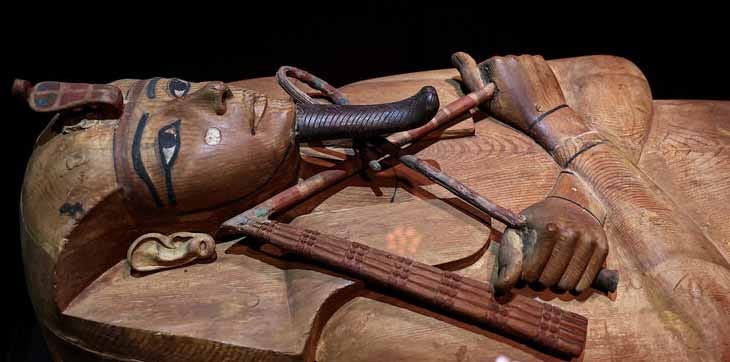
Who was the pharaoh of the Exodus? Well, this (unanswerable!) question is rearing its head again because of a current traveling exhibition. The coffin of Ramses II, the king known to history as “Ramses the Great,” is currently on display in Paris as part of an exhibition organized by Egypt’s Ministry of Tourism and Antiquities. One of the results of all of the international media coverage of the exhibition is a cultural and ideological tug-of-war. According to a recent article by Al-Monitor, the “Western and Israeli” media coverage of the exhibition included discussion of Ramses II as the pharaoh of the Exodus, an event described in the Torah and the biblical Old Testament. The Secretary-General of the Supreme Council of Antiquities, Mostafa Waziry, bristled at the idea that Ramses II was the king of Egypt who, according to the Exodus story, confronted the Israelite Moses and whose stubborn refusal to free the Israelite slaves caused Egypt to endure the ten plagues cast upon Egypt by Moses’ god:
Waziry said that ancient Egyptians never adopted the concepts of killing women or children. He referred to Maat, the ancient Egyptian concept of justice, truth, harmony, law, morality and order, which is regarded as the Egyptian cultural identity.
Egyptologist Mohamed Raafat Abbas spoke to Al-Monitor about the greatness and historial importance of Ramses II. “[The pharaoh] is the direct target of distortion, grudges and spreading poisons of hatred on the part of Egypt's historical enemies because he is considered, beyond any doubt, a true and eternal symbol of the ancient Egyptian civilization,” he said.
“There is no archaeological area in Egypt from the far north to the far south without antiquities bearing the name of Ramses II,” he noted.
The article goes on to say that other archaeologists agree that “the accusation that Ramses II was the Pharaoh of Exodus is based on Zionist propaganda.” Yikes. And who wants to claim that antiquity isn’t relevant to the modern world?? There is no doubt that this article is biased in favor of a view of Ramses II—and a positivist view of authoritarianism—that Egypt’s Ministry of Tourism and Antiquities is eager to promote. We share it here as a reminder that all histories have an agenda (even us!), and we must learn to discern the agenda(s) of any source that comes before us. Some—like this one—are easy to identify as having a propagandistic bent, but as we all continue to be bombarded with content in this unprecedented age of masses of contradictory information, we must all “stay frosty” (as Kara would say).
“Is Ancient Glass Unbreakable?”
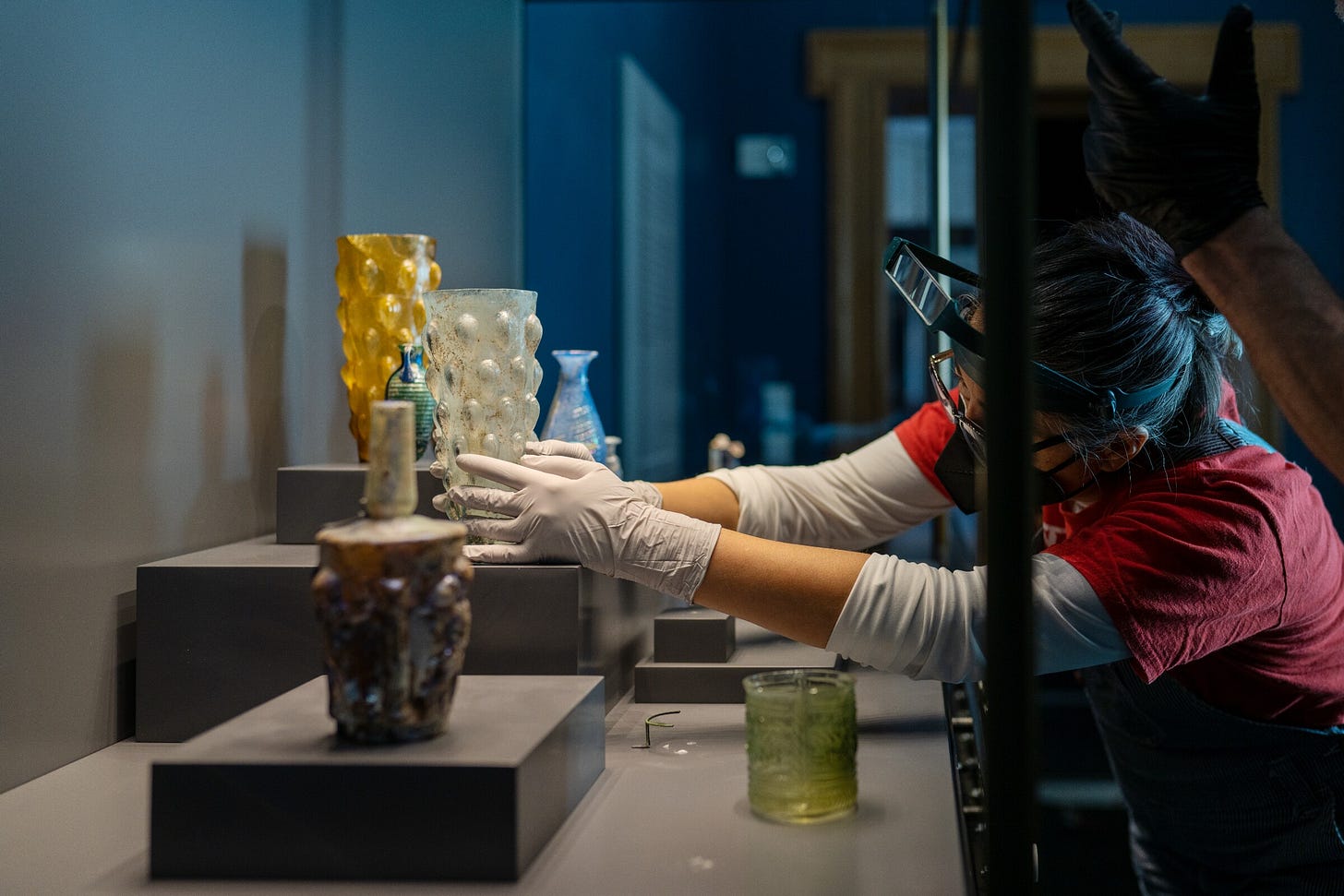
Thanks to its initial rarity and the skilled labor required to make it, glass was valuable in the ancient world, and its possession was limited to society’s wealthiest members. Ancient glass sitting in display cases in museums across the world today largely owes its survival to burials—where it was more likely to remain intact.
“The ones that are preserved, in good condition, and in one piece were always found in a burial,” says Anastasios Antonaras, an archaeologist and curator at the Museum of Byzantine Culture in Greece and an expert on ancient glass. “So that preserved their integrity.”
Last year the Getty Villa uninstalled most of its Greek and Roman glass exhibit so that each piece could be photographed, weighed, and further analyzed by Antonaras, who is writing a catalogue on the collection. Check out this Getty news article if you want to learn some of the methods and materials used by the Getty’s experts to preserve and safely install ancient glass in the museum’s galleries. You can also watch the Getty Villa’s team handling the ancient glass (very carefully!!) as they re-install it for display in the museum in this video.
Tracing the invention and evolution of clothing in the world’s colder climates

Humans get cold because they move to places for which their bodies were not originally adapted. Recently Sapiens featured a story on the origins of Paleolithic clothing by Ian Gilligan (honorary associate in the School of Humanities at the University of Sydney in Australia), whose research interests include the origins of clothing and answering the question of why humans are the only animals to have adopted clothing. Given that zero examples of Ice Age (2.6 million-12,000 BCE) clothing survive, perhaps archaeologists can be forgiven for neglecting this area of research in the past. However, Gilligan’s research is beginning to offer some insights into the origins of clothing and suggests it first fulfilled biological needs and then cultural ones. Although the clothes don’t survive, the tools associated with making clothing do survive—stone hide scrappers, blades, awls (a hide-piercing tool), and eyed needles used for sewing more complex clothes. The ability of some early humans to make more complex clothing (as evidenced by eyed needles) enabled them to move into harsh, frigid environments where other animals could not follow:
Northern China had blade tools from 40,000 years ago, bone awls from 35,000 years ago, and eyed needles from 30,000 years ago. In Europe, eyed needles accompanied Homo sapiens toward the coldest part of the last glacial cycle, the last glacial maximum, around 22,000 years ago.
Back in Siberia, eyed needles allowed our species to penetrate the frigid Northeastern corner of Eurasia, where even Neanderthals—who lacked eyed needles—never ventured during peak glacial times.
In environments where proper protective clothing was a life and death matter, it is fascinating to think of a tool like the eyed needle being the determining factor in the survival and movements of early Homo sapiens. (For those of you who sew, rejoice at your power!) Beyond survival, evidence suggests that as cultural complexity increased, clothing became a significant cultural factor:
Once the new decorative function of clothing became entrenched, the desire to wear clothes was uncoupled from climate. Instead of temperature, social and psychological factors inspired humans to cover up.
To put it more simplistically, fashion was born—but it was the hairless skin of of the early (cold!) humans that set us squarely upon the path to such fancy schmancy Met Gala style:
Coming soon: Online courses with Kara!
Have you ever wanted to take a course on ancient Egyptian religion with Kara? Well, you’re in luck. This week Kara was busy recording lectures for two upcoming online courses that we’ll be offering in partnership with Derek Lambert of MythVision, a content creator who has the platform necessary for such a class and shares our enthusiasm for sharing quality content about the ancient world with public audiences. These two courses will cover ancient Egyptian Genesis (cosmology and cosmogony for those who like the fancy Greek words!) and death and resurrection Egyptian style. They are tentatively scheduled for release sometime this summer, and we will share all of the details here as soon as we have them. Stay tuned!
What else were we reading this week?
The Ishtar Gate of Babylon: One Monument, Multiple Narratives
Pennyroyal, Mifepristone, and the Long History of Medication Abortions
Mystery warriors made the fastest migration in ancient history
Buddha statue unearthed at temple in Egypt's Red Sea region
Hidden contents of 6 ancient Egyptian coffins, sealed for thousands of years, revealed
The Untold History of Japan’s Women Artists
2,600-year-old stone busts of 'lost' ancient Tartessos people discovered in sealed pit in Spain
Is a Michelangelo Self-Portrait Hidden In His Famous Fresco?
Report Finds Major Provenance Holes in Met Museum’s Native American Art Collection
Beware the Rise of Anti-Anti-Colonialism
One more thing…
Those of you who caught the last edition of Ancient/Now will recall the latest dust-up over Cleopatra VII’s skin color and the casting for Netflix’s upcoming Queen Cleopatra documentary. Since then the Egyptian Ministry of Tourism and Antiquities issued a lengthy statement declaring that “Queen Cleopatra was light-skinned” and had “Hellenistic features.” Dr. Zahi Hawass also doubled-down on this position with the dogmatic pronouncement that “Cleopatra was not black.”
Besides noting the fact that Cleopatra could have had an Egyptian mother(!!) as she spoke and read Egyptian (language acquisition in mixed families often goes through the mother!), we’re going to give the last word on this to Dulcé Sloan, who recently guest hosted Comedy Central’s The Daily Show.







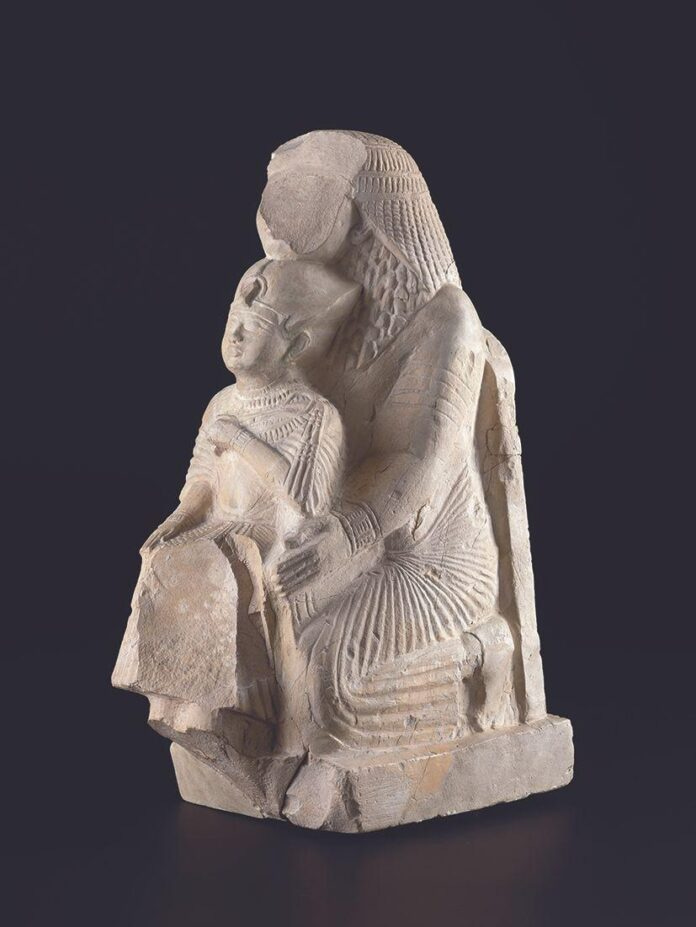
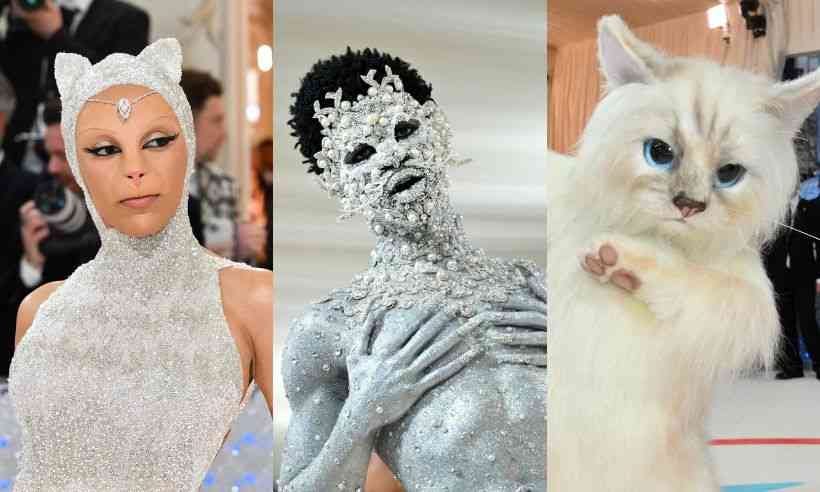

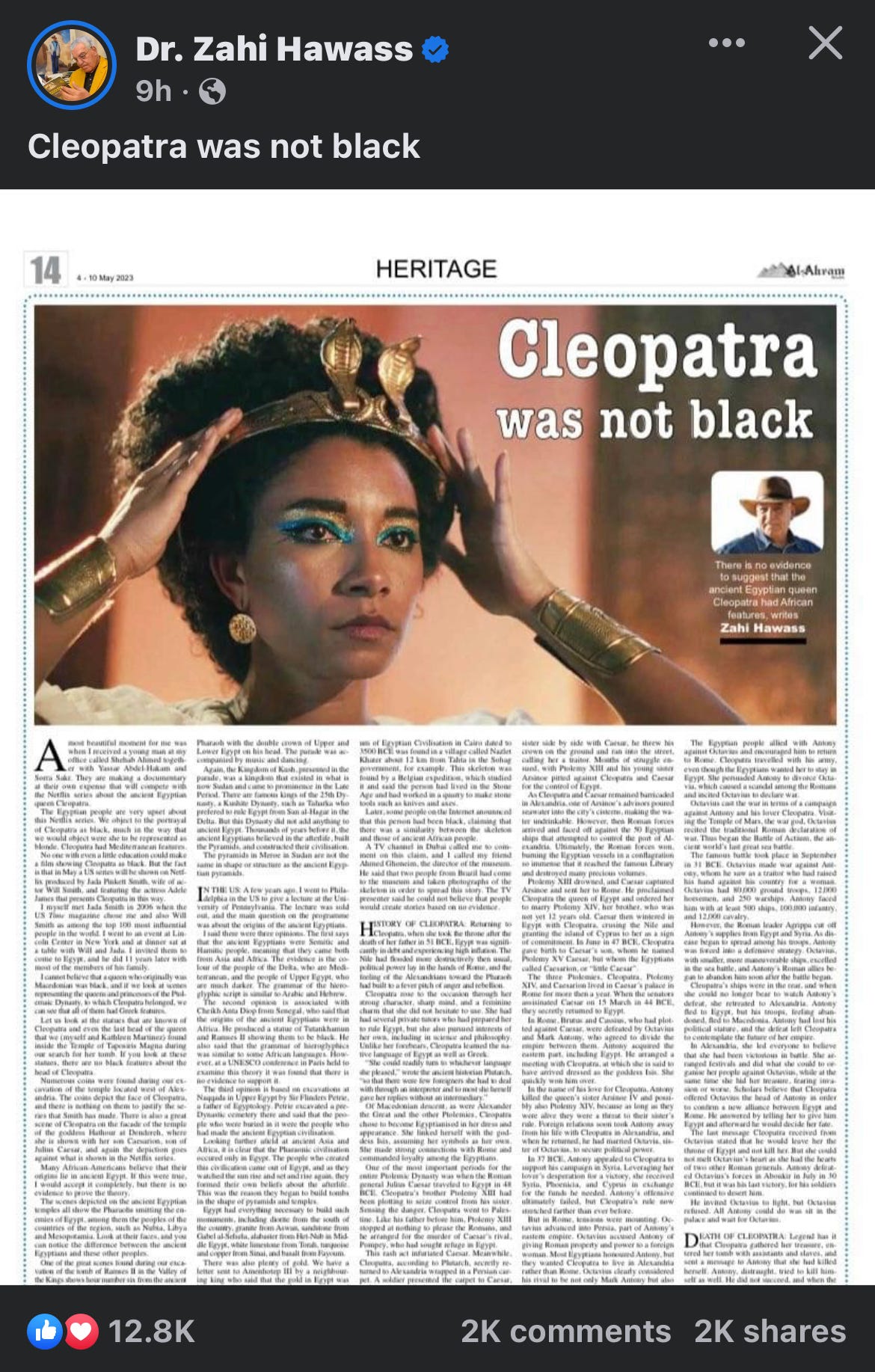

Hi Kara, thanks so much for your comments! I also considered the obvious possibility that the statue in Edinburgh might represent an official dedicating a statue of Amenhotep I, but the few other examples of this rare statue type that commemorates donors offering statues of a king still have surviving inscriptions that indicate that they depict high officials presenting statues of the deified living king, including Vizier Panehesy offering a statue of Merneptah and a royal wife and Vizier Hori offering a statue of Ramesses III! They were all found in or around the Khenu chapel of the Hathor Temple at Deir el-Medina, which was originally established for the deified form of reigning king Ramesses II by Vizier Paser and Senior Scribe Ramose, hence their identification as possible candidates for the statue in our collection. I think this unique statue form was probably a privilege in honour of Deir el-Medina's special relationship with the king. There’s more on my blog & in the original open access article:
http://www.eloquentpeasant.com/2022/07/26/the-king-and-i-the-politics-of-royal-statue-dedication-and-patronage-at-deir-el-medina/ Thanks again for your interest!